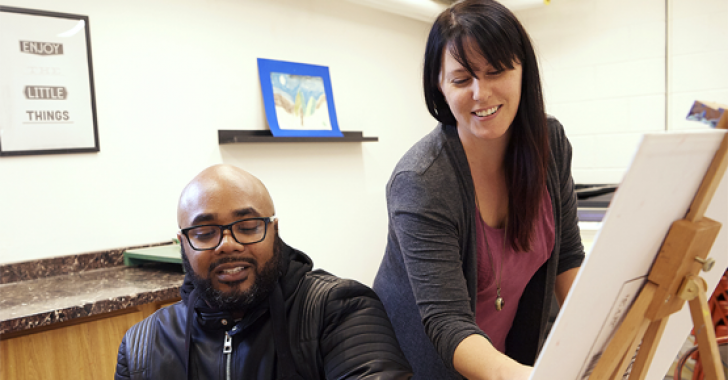Why Art Therapy Works
Q&A with a Therapist: Lara Haagen on Why Art Therapy Works
Lara Haagen is an art therapist at Eagleville Hospital and serves as Eagleville’s Adjunctive Therapies Clinical Coordinator, overseeing everything from the gardening program to a music appreciation group.
We asked Lara to describe her work and explain how art is uniquely helpful to people in recovery.
What is art therapy, and how is it different from talk therapy?Just like talk therapy, art therapy is about helping clients make positive changes through the relationship between client and therapist. But speech and art are different, of course, for many reasons.
First, art lives deeper in our brains than speech. Before we could talk, we thought in pictures. Images reach a part of our brain we don’t consciously access very often. That’s important because the same is true of trauma. Normally, we go through our days labeling experiences, putting words to them and filing them away. But when we experience something traumatic, the frontal lobe shuts down, preparing us for “fight, flight or freeze.” The end result is that the brain didn’t have a chance to label the experience, which can trigger troubling nightmares and flashbacks. It can be healing to take something from the mind, put it on a canvas, assign it words and labels and take control of it.
Second, creating art can restore imagination. A lot of clients dealing with trauma, addiction, or co-occurring disorders live in a state of constant red alert, which means they’re not thinking about the future. If you can’t see how your life could be different, you can’t begin to work toward that. Restoring a person’s ability to imagine, and providing them a safe space to do so, helps them to picture a life in which they’re successfully managing addiction and working toward personal dreams and goals.
Finally, choice is huge when it comes to making art. In acute and in-patient care settings, clients’ lives are regimented to keep them safe, but it also means they can’t make all the decisions. Creating art can restore a sense of agency. They choose what to make, what materials to use, and how they’re going to express themselves.
What might a typical art therapy session look like?The practice of art therapy exists on a spectrum. At one end is art psychotherapy, which involves processing art work created in a therapy session with an art therapist. Because we’re so used to editing ourselves when we talk, drawing or painting or engaging in some other creative process can help us to communicate and express in a different way. The interaction and relationship with the therapist is important here, and the focus is more on the art-maker’s process.
On the other end of the spectrum is “art as therapy.” Think of this as the basic healing processes that occurs when you create something. In this mode, the focus is more on the product and the accomplishment.
At Eagleville, we offer both art psychotherapy and art as therapy.
Are clients ever intimidated by the idea of creating art?Yes, that’s common. The relationship between the art therapist and the client helps to mediate feelings of insecurity or anxiety. Support and encouragement is key. We try to frame art as a healthy risk, and with the right support in the therapeutic relationship, clients do take that risk. At the end, they’re often proud of what they’ve been able to create and to communicate.
It’s also important to remember that it’s not an art class. In the art psychotherapy setting, I’m not teaching or evaluating””I’m here to help you express yourself in a different way. It’s not about the product: it’s about whatever is happening for you right now.
What do you recommend for someone in recovery who enjoys creating but doesn’t have the time, space or resources for art?Taking the time to be creative for yourself is great for mental and spiritual health. Anything that carves out time for yourself and offers a moment of self-reflection is wonderful.
If someone has a particular interest in art, I advise them to find affordable art supplies at big box stores, garage sales””even nature is full of items that can be used in art. It’s amazing what can come from limitations!
Of course, creativity is not limited to the fine or visual arts. Many activities are creative, whether it’s journaling, writing poetry, singing, playing an instrument, crafting, dancing, knitting, cooking, photography, working on cars, making movies”¦the list goes on and on. I highly encourage people in recovery””and even those who aren’t””to reap the benefits of these creative practices.

